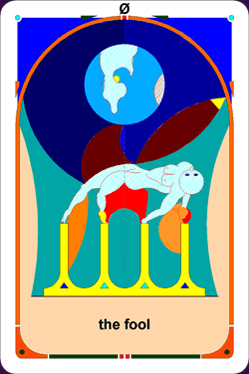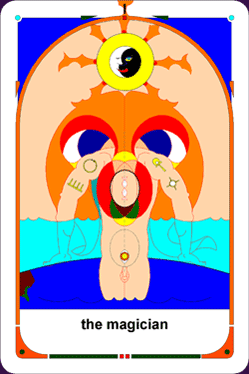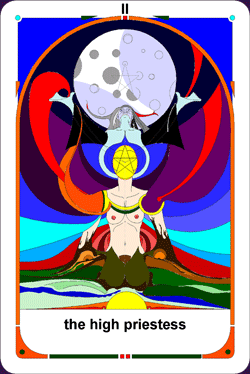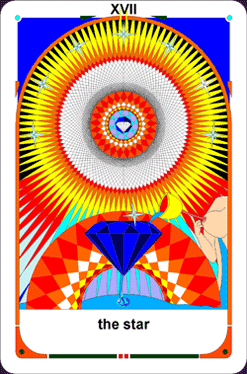Mystereum Tarot Deck Review

The Mysterium Conunctionis Tarot is based in the roots of the meaning of architecture. "Where arche is the first spark, the inception of The Magician; techne is the making, the putting together, the conception of the High Priestess; carrying form to full term of The Empress; The overseer of The Emperor going step by step... even in surprise, going step by step the whole system can be re-aligned." It has been available in a self-published edition, and now has also been expanded as the Tarot in the Land of Mystereum.
Deck Type: Tarot Deck Cards: 78
Creators: Jordan Hoggard
Publisher: Self Published 2008
Retailers
This deck is rare or out of print and isn't easy to find. Search for it on eBay or Amazon.com, or browse our most popular Tarot decks.Mystereum Tarot Review by Bonnie Cehovet
The “Mystereum Tarot” is a 78 card, independently produced Tarot deck from architect/artist Jordan Hoggard. Done on the vector-based system that he uses in his architectural work, the format makes use of geometric form and strong presence of color – red, yellow, blue, orange, green, brown and white. Included with the deck is a 46 page LWB (Little White Book), along with a three page foldout called an “Intro Cardlet”, consisting of a front page, a page of symbols, a blank page where personal favorite symbols can be placed, a page presenting sample spreads including the traditional Celtic Cross, one, two and three card spreads, a page listing Hoggard’s personal thoughts on working with the Tarot, as well as a blank page for the creation of your own personal spread. I should note that when I refer to “blank” pages, I am referring to pages that show the “window framing” on each of the Tarot cards, with a blank center to use as work space.
The thought behind this deck came from the connection between the meaning of architecture and the Magician and High Priestess cards. The Greek roots of the term architecture break down into arche, meaning the creation, or first spark of an idea, the place of inception, and techne, meaning giving form to the formless, the place of conception. The Magician is seen as sparking creation, and the High Priestess as giving it form.
Architecture gave the deck its form, but it also plays its own part in the journey. Hoggard shares with the reader his four-point mode for analyzing architecture:
1. How does a building stand on the ground?
2. How does a building extend to the sides?
3. How does a building open and close?
4. How does a building meet the sky?
If we take the metaphor of architecture into the story of the Tarot, and the path the Fool follows towards individuation, we find ourselves in the middle of an amazing experience! Hoggard notes that a single card may choose to speak on its own, or it may become part of a chorus with other cards. As any reader knows – this is what is!
The LWB that comes with the deck has a picture of the High Priestess on the front (as does the box). It is text only, and written in incredibly small type (and yes – I am aware that this is my almost 60 years of age catching up with me!). There is a reason that I keep a magnifying glass by my computer!
There is a short but quite interesting introduction – a story that is a combination of Hoggard as a person, and how this deck was conceived. The cards themselves are presented without scans, with a discussion of the card’s quality, along with it’s upright and reversed meanings.
From the LWB: (text on The Fool, somewhat paraphrased) - The Fool is said to be the origins of the journey and the journey, at the same time. This is the card of the liberated spirit – perhaps freed from enforced ignorance. The Fool is the origin of the journey, his travels are vast, with infinite experiences. The Fool can indicate a distinction between one’s wants and actualities. Hoggard sees the Fool as an androgynous character, representing the joining of mind and body. The Fool is the Divine presence in all of us.
The box that the cards come in is a beautiful presentation, with the High Priestess on the front, commentary on the deck on the back, card information on the bottom flap, and a stunning out-take from The Star on the two sides. My problem with the box is that (a) it is of flimsy construction, and (b) it is a fraction too deep, allowing the cards to rattle around a bit. When I first submitted this review, I left my issue with the box just as you see it. I was very lucky, in that Jordan saw the review, and explained how the box came about. Please remember – this deck is an Indie, and cost is a consideration. What I didn’t know was that Jordan printed, cut, and folded them himself! That is something that is not obvious. The work is well done – the flimsiness is not something that Jordan likes either, but it was part of the process. Lesson learned here – if something feels a little off – ask about it!
The cards themselves are 2 ½” by 3 ½”, of good quality, glossy card stock – easily handled by smaller hands. The card backs come from a window project that Hoggard did for a client – the window acts symbolically as a portal into the wisdom of the Tarot. Use is made of white blinds, a blue background, and beautiful gray leaves, with a reflection from the top of the window to the bottom, making the backs fully reversible.
The card faces show a ¼” white border, with dark blue in the upper right and left hand corners. A lighter blue, with a thin orange inner border, provides the top of the window that allows us to see into each card. The sides an bottom of the window are a dark orange. The bottom of the card carries a white strip with black text identifying the card: the Major arcane show the card name in English, French, German, and Spanish, with the number (in Roman numerals) in the center. The Fool shows a lemnescate over the Roman Numeral 0.
The numbered cards show the same ¼” white border, with the dark blue upper right and left hand corners, and the colored “window frame”. There is a white strip with black text at the bottom of the card with the number in the middle, and the suit name in English, French, German and Spanish on either side.
The Court Cards show the same ¼” white border, dark blue in the upper right and left hand sides of the card, and the colored “window frame”. There is a white strip with black text at the bottom of the card with the card title in the middle, and the suit name in English, French, German and Spanish on either side.
The images in this deck are not of the traditional Rider-Waite-Smith school. There is good use made of esoteric symbolism, which often occurs in unexpected places. The Fool appears as an androgynous figure, draped over four pillars, with one limb balanced on each pillar. His eyes are black holes, similar to the work of Johanna Gargiulo-Sherman in the “Sacred Rose Tarot”. Above the figure we see a figure of the world. The Emperor is an interesting card, showing a figure in the middle of a tree, with two figures in a green field in the background. The Hierophant shows a Buddha-like gray figure, with a triangular brown backdrop. The Lovers carries on the imagery of the four pillars as a backdrop to the two figures, with an interesting nod to intuition – the symbol of a cup in the third eye area of one of the figures. The Wheel is interesting for its watch-like imagery, and the astrological glyphs used. The Hanged Man is interesting in that is hands are held out on either side of his head, with a loose rope between them that includes a lemnescate (which also appears behind his head). The Devil shows the traditional male/female/devil imagery, with a continuation of the four pillars symbol in the upper right hand corner. The Tower includes traditional imagery, along with a miniature glyph of the Fool poised over the four pillars in the upper left hand corner. The four pillars appear yet again at the bottom of the imagery for the Sun. Judgment follows the Rider-Waite-Smith imagery closer than the other cards, showing the three figures standing with their arms raised to an Angel with a trumpet. The World is quite an intricate card, showing a foot in the bottom left hand corner of the picture that is starting out on the green path ahead of it. The path is superimposed over a yellow “ribbon” that curves in on itself at the top, as in a figure eight. Astrological glyphs for Leo, Virgo, Aquarius and Taurusshow at the top of the card.
The Pips (numbered cards) are what I might call “semi-illustrated”. Traditional symbols are used, with minimal figures or other background images. In the suit of Pentacles, some of the symbols appear dark, and some light. The Ace is dark, the Two shows one of each, the Three and Four show all light symbols, the Five is all dark, the Six is split 50/50, the Seven and Eight all light, the Nine is split (with very interesting imagery – two hands with Pentacle symbols at the end of each digit – the little fingers sharing a symbol). The Ten shows all dark symbols.
The suit of Cups shows something a bit different – divisions down the middle of the Two of Cups, the Three of Cups, the Seven of Cups and the Nine of Cups; the Five of Cups flowing from the upper left hand side to the lower right hand side of the card, each at a different angle; the Seven of Cups all upright, shown against the background of a fluffy cloud; the Eight of Cups showing yellow Cups tumbling on a green background from the upper right hand side of the card to the lower left hand side (which shows the imagery of a cloud); the Nine of Cups are shown upside down, placed between tendrils coming from a central yellow figure; the Ten of Cups shows somewhat traditional imagery, with fields and a house, and a rainbow of upright cups over them.
The suit of Wands carries similar imagery through several of the cards. The Three of Wands shows the symbols crossing and on either side of a body of water than runs up into a mountain. The Four of Wands shows the symbols upright in the lower right hand side of the card. The Five of Wands shows two figures dueling in the center of the card, with one of the upright figures from the Judgment card at the bottom, and the two figures from the background of the card of the Hierophant in the upper middle. A rainbow is placed in back of the mountain, and a sun to the right hand side.
The suit of Swords starts out by using the four pillar imagery in the Two of Swords. The Three of Swords shows the traditional heart with swords thrust through it; the Six of Swords shows a hand with the sword symbol superimposed on each of the digits, with the sixth sword on the right hand side; the Ten of Swords is unique in that the number ten has been left off of the bottom of the card – instead, it appears as a “ghost” Roman numeral high in the sky.
The Court Cards are interesting in that a miniature symbol of the Queen from each suit is included in the imagery for the card of the King. The Page of Cups shows the figure from the Hanged Man – this time in an upright position. The larger picture also shows his belt – which makes use of the four pillar imagery from the Major Arcana. The figure from the Hanged Man also appears as the Page of Swords – this time reaching towards a sword that appears to be balanced on his head.
This is not a traditional deck, and while it can be read with, I would say that it would be better used for meditation or journey work, by someone who was familiar with esoteric material.
Complete Details of Mystereum Tarot
Also known as Mysterium Conunctionis Tarot
Creators: Jordan HoggardPublisher: Self Published 2008
Deck Type: Tarot Deck
Cards: 78
Major Arcana: 22
Minor Arcana: 56
Deck Tradition: Rider-Waite-Smith
Suits: Pentacles, Wands, Swords, Cups
Court Cards: Page, Knight, Queen, King
Major Titles: 0 The Fool, I The Magician, II The High Priestess, III The Empress, IV The Emperor, V The Heirophant, VI The Lovers, VII The Chariot, VIII Justice, IX The Hermit, X The Wheel, XI Strength, XII The Hanged Man, XIII Death, XIV Temperance, XV The Devil, XVI The Tower, XVII The Star, XVIII The Moon, XIX The Sun, XX Judgement, XXI The World
The Fool is 0
Strength is 11
Justice is 8
Card Size: 2.50 x 3.50 in. = 6.35cm x 8.89cm
Card Language: Spanish, German, French, English
Card Back: Reversible
Back Design: A window with reflected pairs of trees, full color.
Companion Material: 192 Page "Imagination Primer" book.
Rating: 14/20 or
Similar Decks to Mystereum Tarot
Creator: Tarot in the Land of Mystereum by Jordan Hoggard< Previous Deck · Back to Top · Next Deck >
Home > Tarot Reviews > Mystereum Tarot Review





